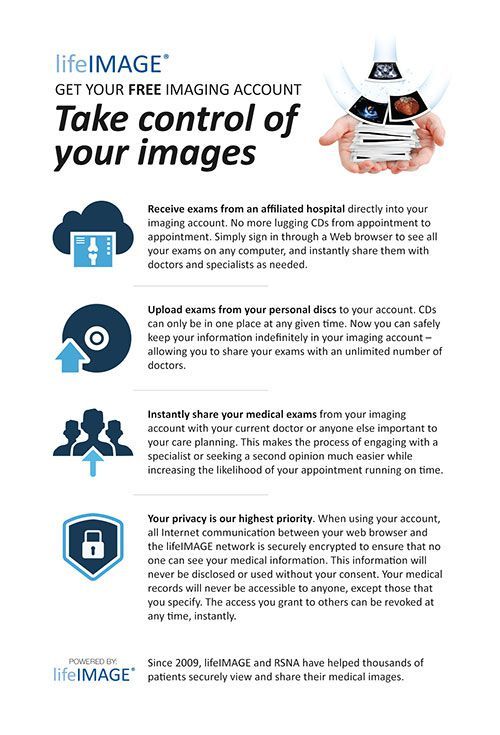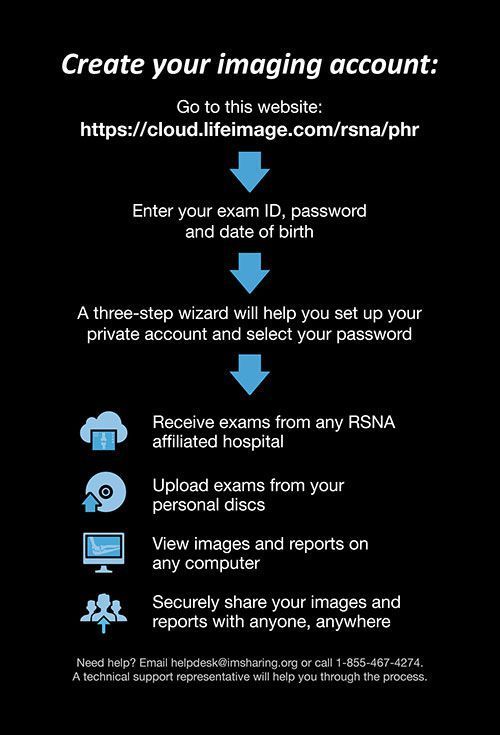New research presented at the annual meeting of the Radiological Society of North America (RSNA 2014) shows that patients value direct, independent access to their medical examinations. In the new study, researchers evaluated patient and provider satisfaction with the use of RSNA Image Share, an internet-based interoperable image exchange system that gives patients ownership of their imaging exams and control over access to their imaging records.
RSNA Image Share enables radiology sites to make imaging exams available for patients to incorporate in personal health record (PHR) accounts they can use to securely store, manage and share their imaging records. Through the network, sites can also send patient imaging records to other participating sites to support better informed care.
"Easy and timely electronic access to an online unified source of radiologic exams under a patient's direct control can potentially improve healthcare quality, enhance the patient's engagement in their medical care, and reduce unnecessary imaging utilisation and exposure to ionising radiation," explained Giampaolo Greco, PhD, MPH, assistant professor in the Department of Population Health Science and Policy at The Mount Sinai School of Medicine in New York City.
Previous research has shown that fragmentation of health information amongst physicians, healthcare institutions or practices, and inefficient exchange of test results can decrease quality of care and contribute to high medical costs. Improving communications and giving patients more control over their care are critical goals of many current health IT initiatives.
"RSNA Image Share is a standards-based solution designed to achieve full interoperability of health information technology systems. Anyone, physician or other, no matter their location or affiliation, can view the images with proper patient authorization," Dr. Greco said.
Unlike other systems based on point-to-point private networks, RSNA Image Share avoids the legal delays and expenses associated with virtual private networks and enables the same flexibility of access characteristic of physical media like CDs. Patients who use this RSNA system have the ability to allow any provider they wish to access their images, as they do with CDs.
For the study, patients undergoing any radiologic exams in four academic centres were eligible to create online PHR accounts using the RSNA Image Share network. Patients could then use their PHR accounts to maintain and share their images with selected providers, creating a detailed medical history accessible through any secure internet connection.
Between July 2012 and August 2013, the study enrolled 2,562 patients (mean age 50.4) including a significant representation of older individuals. Older people have the highest healthcare utilisation and often experience or perceive a significant barrier in using information technology. As Dr. Greco noted: "The high level of enrolment among people in this age group demonstrates their interest in tools that may facilitate the management of their complex medical records and communication with their providers."
According to researchers, the median number of exams uploaded per patient was six. A total of 27,961 exams were uploaded to personal health records, mostly x-ray, followed by CT and MRI.Study participants were provided a brief survey to assess patient and physician experience with the exchange of images, and 502 patients completed and returned their surveys. Of these, 448 patients identified the method used at the visit to share images: internet, CDs, both internet and CDs, or other, and 165 included a section completed by their physician. The survey was completed after sharing the imaging exams with their physician, and was returned by mail.
The researchers reported these key findings:
"We found almost unanimous agreement from patients on the value of having direct, independent access to their imaging exams," said Dr. Greco. "This report shows that an image-sharing solution that is patient-directed and internet-based is feasible and not only facilitates access, but also, with respect to privacy and security, generates the same level of user satisfaction as that attained through CDs."
Asked how the clinicians benefitted, Greco explained that they also developed a survey for the clinician, but the return rate was too low to analyse in a robust manner. However, the small number who did respond gave good responses, probably indicating bias.
The study's co-authors are Anand S. Patel, MD, Sara Lewis, MD, Wei Shi, MS, Mary Torosyan, Alan J. Moskowitz, MD, Rehana Rasul, MS, Bradley J. Erickson, MD, PhD, Atheeth Hiremath, BS, Wyatt M. Tellis, PhD, Eliot Siegel, MD, David E. Avrin, MD, PhD, Ronald L. Arenson, MD, and David S. Mendelson, MD.
Claire Pillar
Managing Editor, HealthManagement
Figure 1

Figure 2

Source: RSNA
Image Credit: RSNA
RSNA Image Share enables radiology sites to make imaging exams available for patients to incorporate in personal health record (PHR) accounts they can use to securely store, manage and share their imaging records. Through the network, sites can also send patient imaging records to other participating sites to support better informed care.
"Easy and timely electronic access to an online unified source of radiologic exams under a patient's direct control can potentially improve healthcare quality, enhance the patient's engagement in their medical care, and reduce unnecessary imaging utilisation and exposure to ionising radiation," explained Giampaolo Greco, PhD, MPH, assistant professor in the Department of Population Health Science and Policy at The Mount Sinai School of Medicine in New York City.
Previous research has shown that fragmentation of health information amongst physicians, healthcare institutions or practices, and inefficient exchange of test results can decrease quality of care and contribute to high medical costs. Improving communications and giving patients more control over their care are critical goals of many current health IT initiatives.
"RSNA Image Share is a standards-based solution designed to achieve full interoperability of health information technology systems. Anyone, physician or other, no matter their location or affiliation, can view the images with proper patient authorization," Dr. Greco said.
Unlike other systems based on point-to-point private networks, RSNA Image Share avoids the legal delays and expenses associated with virtual private networks and enables the same flexibility of access characteristic of physical media like CDs. Patients who use this RSNA system have the ability to allow any provider they wish to access their images, as they do with CDs.
For the study, patients undergoing any radiologic exams in four academic centres were eligible to create online PHR accounts using the RSNA Image Share network. Patients could then use their PHR accounts to maintain and share their images with selected providers, creating a detailed medical history accessible through any secure internet connection.
Between July 2012 and August 2013, the study enrolled 2,562 patients (mean age 50.4) including a significant representation of older individuals. Older people have the highest healthcare utilisation and often experience or perceive a significant barrier in using information technology. As Dr. Greco noted: "The high level of enrolment among people in this age group demonstrates their interest in tools that may facilitate the management of their complex medical records and communication with their providers."
According to researchers, the median number of exams uploaded per patient was six. A total of 27,961 exams were uploaded to personal health records, mostly x-ray, followed by CT and MRI.Study participants were provided a brief survey to assess patient and physician experience with the exchange of images, and 502 patients completed and returned their surveys. Of these, 448 patients identified the method used at the visit to share images: internet, CDs, both internet and CDs, or other, and 165 included a section completed by their physician. The survey was completed after sharing the imaging exams with their physician, and was returned by mail.
The researchers reported these key findings:
- 96 percent of the patients responded positively to having direct access to their medical images, and 78 percent viewed their images independently.
- There was no difference between internet and CD users in satisfaction with privacy and security and timeliness of access to medical images.
- 42 percent of images were shared via the Internet, 15 percent used CDs, 11 percent used both and 32 percent used other methods, as their physicians and radiologists were directly linked.
- A greater percentage of internet users reported being able to access their images without difficulty, compared to CD users (88.3 percent vs. 77.5 percent).
"We found almost unanimous agreement from patients on the value of having direct, independent access to their imaging exams," said Dr. Greco. "This report shows that an image-sharing solution that is patient-directed and internet-based is feasible and not only facilitates access, but also, with respect to privacy and security, generates the same level of user satisfaction as that attained through CDs."
Asked how the clinicians benefitted, Greco explained that they also developed a survey for the clinician, but the return rate was too low to analyse in a robust manner. However, the small number who did respond gave good responses, probably indicating bias.
The study's co-authors are Anand S. Patel, MD, Sara Lewis, MD, Wei Shi, MS, Mary Torosyan, Alan J. Moskowitz, MD, Rehana Rasul, MS, Bradley J. Erickson, MD, PhD, Atheeth Hiremath, BS, Wyatt M. Tellis, PhD, Eliot Siegel, MD, David E. Avrin, MD, PhD, Ronald L. Arenson, MD, and David S. Mendelson, MD.
Claire Pillar
Managing Editor, HealthManagement
Figure 1

Figure 2

Source: RSNA
Image Credit: RSNA
Latest Articles
Internet, health IT, RSNA 2014, #RSNA14, radiologic exams, CD
New research presented at the annual meeting of the Radiological Society of North America (RSNA 2014) shows that patients value direct, independent access...



























